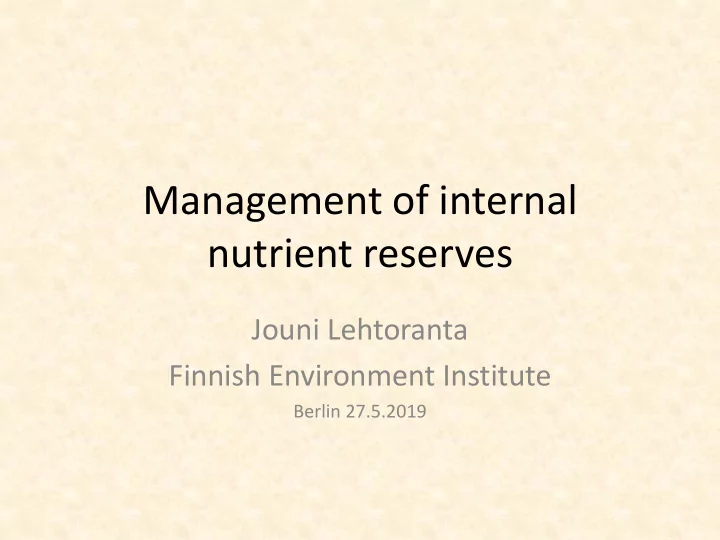

Management of internal nutrient reserves Jouni Lehtoranta Finnish Environment Institute Berlin 27.5.2019
Biogeochemical cycle Biogeochemical cycle Cycle where element or molecule is transferred between biotic and abiotic systems Reservoir Element stays very long in same place (apatite-deposit) Exchange pool Element is stored for a ”short” period of time Abiotic system forms commonly long term pools and exchange pools are formed by biota Residence time Abiotic environment Period of time which element stays in one place Water = hydrosphere Earth’s crust = lithosphere Air = atmosphere 31.5.2019
Phosphorus pools
PROBLEM IN THE BALTIC SEA Reactions in water Water Sediment Reactions in sediment 31.5.2019
INTERNAL PROBLEMS IN BALTIC SEA • Stratification properties of the Baltic Sea – Sensitivity towards anoxia • High quantity of phosphorus in bottom sediments • Poor natural ability of the sediment to retain phosphorus permanently
As a result in the Baltic Sea Savchuk 2016
• First basin to achieve a status without eutrophication will be Arkona, between 2030 and 2040 • By 2060–2070, a status without eutrophication is anticipated for the Kattegat, Bornholm Basin and Gulf of Finland, • The Danish straits around 2090 • For the Baltic Proper and Bothnian Sea, a good status with regard to eutrophication is not expected before 2200 • Authors conclude that the basins Gulf of Riga and Bothnian Bay are not likely to meet the targets agreed upon and to attain a status unaffected by eutrophication
Proportion of background loading Human activities cause 70% of the loading for phosphorus from Finland is 30% Still great potential to eutrophy the Baltic Sea! 31.5.2019
MANAGEMENT OF NUTRIENTS AND RISKS FOR ECOSYSTEMS P Phosphorus 30.974 • Case re-eutrophication of Lake Erie N • Case artificial wetland in Finland Mn Nitrogen 14,007 Manganese 54,938 • All present measures to reduce loading from the diffuse sources
Internal measures are based on following mechanisms • Improve the geochemical conditions so that nutrients are retained in bottom sediments • Remove the nutrients from the system • Add compounds which bind nutrients in the system
Experiments in the Baltic Sea
Artificial oxygenation to improve the geochemical conditions Model MC 1100 (Water-Eco ltd) - Power 2.5 kW - Water discharge 87 000 m 3 /d - 800 kg O 2 /d Surface areas 0.5 km 2 and 7 km 2
Variation in oxygen, H 2 S, phosphate and total-P Pumping area Reference basin 15 10 5 0 -1 -5 -10 -15 -20 -25 -30 -40 Oxygen & H2S 15 10 5 0 -1 -5 -10 -15 -20 -25 -30 -40 Oxygen / H2S (mg/L) (mg/L) 0 3 8 10 15 16 19 24 2009 2010 2011 2009 2010 2011 500 400 300 200 100 50 10 0 500 400 300 200 100 50 10 0 PO4-P (µg/L) PO4-P (µg/L) 0 3 8 10 15 16 19 24 2009 2010 2011 2009 2010 2011 500 400 300 200 100 50 10 0 500 400 300 200 100 50 10 0 Tot-P (µg/L) Tot-P (µg/L) 0 3 8 10 15 16 19 24 2009 2010 2011 Lehtoranta et al. 2018 2009 2010 2011
Finland: Variation in oxygen and phoshorus 0 Depth (m) 10 Float 20 30 2006 2007 2008 2009 2010 2011 O2, mg/l 0 1.5 3 4.5 6 7.5 9 10.5 12 13.5 15 16.5 18 0 Depth (m) 10 Float 20 30 2006 2007 2008 2009 2010 2011 PO4, µg/l 0 20 40 60 80 120 160 200 240 280 320 360 400 Lehtoranta et al. 2018
Compound additions to improve the binding ability • On fields gypsum, structure lime • On sediments – Aluminium compounds – Iron compounds – Phoslock, lanthanum (LaPO 4 ) – Marl – Zeolite/hydrous zirconia (Fan et al. 2017, Wat. Res.)
Alum additions Björnöfjärden • Treated area 0.73 km 2 Rydin and Gumblad 2019 Capturing past eutrophication in coastal sediments – Towards water-quality goals
Additions of marl • First pilot experiments with residue marl from pile in Gotland will be carried out in Östergötland, Stockholm • The suitability of local limestone residues in Parainen will be studied for piloting in the Archipelago Sea of Finland
Removal of bottom sediment Dredging test for underwater units showing that they are capable of retrieving a top layer of sediment from seabed, down to 120 meters water depth. Seabased project: Pilot experiment in the Archipelago Sea Finland Semienclosed bay 0.01 km 2 with reference area
Technology readiness level (TRL)
Thank you Photo: Ilkka Heikkinen, Inkoo 31.5.2019
Definition • Ecological engineering • Seabased measures • Management of internal nutrient reserves
Recommend
More recommend